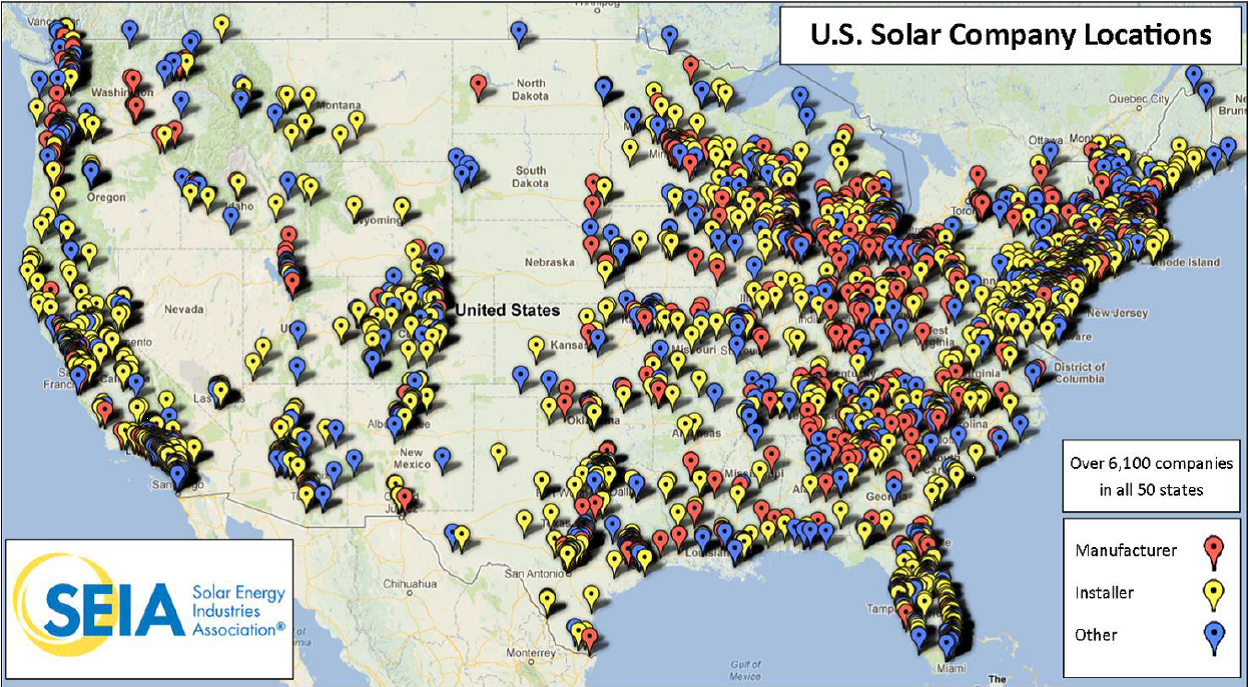Last week, I was invited to testify at the U.S. House of Representative’s Energy and Commerce Committee, Energy and Power Subcommittee’s hearing on “Laboratories of Democracy: The Economic Impacts of State Energy Policies.” My remarks focused on the tremendous success story of state renewable electricity standards (RES) and the important economic benefits they are delivering to state and local economies, as described in more detail in this 2013 UCS report.
Combined with federal tax credits, state RESs are supporting hundreds of thousands of jobs, increasing domestic manufacturing at hundreds of facilities in nearly every state, investing billions of dollars of new capital in state and local economies, and providing hundreds of millions of dollars per year of new income to landowners and rural areas. And states are realizing these benefits, along with significant environmental benefits, at little to no cost to consumers.
Below are the remarks I made at the hearing, and here’s the link to my longer written testimony. Steve Nadel, Executive Director of the American Council for an Energy Efficient Economy (ACEEE), also submitted excellent testimony on the success and economic benefits of state energy efficiency policies.
******************
Good morning. On behalf of UCS and our 450,000 members and supporters, I would like to thank Chairman Whitfield and the other distinguished members of the Subcommittee for the opportunity to testify today.
My comments will focus on how state renewable electricity standards have been a key driver for the recent growth in the U.S. wind and solar industries, spurring innovation and creating new jobs and income for state and local economies. I will also show how utilities in most states are meeting or exceeding their targets at little to no cost to consumers. Finally, I will highlight how stronger federal policies are needed to complement state renewable energy policies.
Renewable standards are a primer driver for renewable energy
A renewable electricity standard requires electric utilities to gradually increase the amount of renewable energy in their power supplies over time. Renewable standards have been adopted in 29 states and D.C. (see Figure 1). Seventeen states and D.C. have renewable standards of 20% or more, and 18 states have increased or accelerated their targets since originally adopting them.
Lawrence Berkeley National Lab (LBNL) estimates that 46,000 MW or more than two-thirds of all renewable energy capacity installed in the U.S. between 1998 and 2012 occurred in states with renewable standards. LBNL projects this amount to more than double to 94,000 MW by 2035, as states continue to ramp-up their standards. California’s 33% by 2020 standard creates the nation’s largest market for renewable energy, followed by Illinois, New Jersey, Texas, and Minnesota.
State renewable standards, combined with federal tax credits, have played a key role in the rapid growth of the U.S. wind and solar industries. Wind power has accounted for nearly one-third of all new electric generating capacity in the U.S. over the past five years, second only to natural gas. And 9 of the top 10 states in total installed wind capacity have renewable standards.
U.S. solar capacity has increased by a factor of ten since 2009, and a record 5,000 MW of solar was installed in the U.S. in 2013. All of the top 10 states with the highest installed solar photovotaic (PV) capacity have renewable standards.
Renewable standards are delivering significant economic benefits
The wind industry has invested over $100 billion in the U.S. economy since 2007, and supports over 50,000 direct jobs, according to AWEA. Texas, the national leader in installed wind capacity, also has the most wind-related jobs with over 8,000, followed by Iowa, California, Illinois, Colorado, Kansas, Michigan, North Dakota, Oregon, and New York. All of these states have renewable standards, except North Dakota, which has a non-binding goal.
Domestic manufacturing of wind turbine components has also grown significantly as state renewable standards have ramped up. More than 560 facilities in 43 states manufacture components for the wind industry (see Figure 2). The domestically sourced content of U.S. wind projects installed today is over 70 percent, up from less than 25 percent in 2005.

Figure 2. U.S. Wind-Related Manufacturing Facilities, 2013. Source: AWEA 2014.
Wind power is also providing a significant source of income and tax revenues for many rural communities. For example, wind projects in Iowa, which now generates more than 27 percent of its electricity with wind, provided $16 million in annual lease payments to landowners and nearly $20 million in annual property-tax payments to local governments.
The solar industry has invested nearly $34 billion in the U.S. economy over the past three years. More than 142,000 people work in the industry at 6,100 businesses located in every state, according to SEIA and the Solar Foundation (see Figure 3). While California leads the nation with over one-third of these jobs, states in the Midwest, Northeast, Southeast, and Southwest are also in the top 10.

Figure 3. U.S. Solar Company Locations. Source: SEIA 2014.
Renewable standards have also been a key driver for technology innovation and the recent cost reductions for wind and solar. The total cost of generating electricity from wind power has dropped 43% since 2009. Since the beginning of 2011, the average price of a solar PV panel has declined 60%. Improvements in wind technology, particularly taller towers and longer blades, has also opened up new opportunities to develop wind power in places such as Michigan, Ohio and the Southeast, which were previously considered economically marginal.
Renewable standards are a good deal for consumers
The falling costs of wind and solar have allowed most utilities to fully comply with state RESs at little to no cost to consumers, and in some cases even net savings. In May, NREL and LBNL released a comprehensive study of state RES costs and benefits, relying primarily on data from utilities and state regulators. The study found that between 2010 and 2012, the cost of complying with renewable standards in 25 states ranged from a net savings of 0.2% of retail rates to a net cost of 3.8%, with a weighted average cost of 0.9%.
These cost estimates are considerably lower than the Beacon Hill Institute studies mentioned in Mr. Tanton’s testimony. UCS and several other groups have identified several serious flaws in these studies funded by the fossil fuel industry that lead to highly exaggerated costs. For example, the NREL report cites a rate impact of 2.2% in Kansas based on data from the state’s public utility commission, compared to Beacon Hill’s estimate of a whopping 45% rate increase.
The NREL report also evaluated emission reductions and health benefits, economic development benefits, and wholesale market price suppression benefits from state renewable standards. Each of these benefits were similar and often higher than the relatively modest costs impacts. A recent LBNL study also found that wind projects can provide a long-term hedge against natural gas, even in an era of low natural gas prices.
Stronger federal policies are needed to complement state renewable standards
The Energy Information Administration projects that existing state and federal renewable energy policies will increase non-hydro renewable energy sources from 6% of U.S. electricity mix in 2013 to 9.4% by 2030. Clearly, we can and should do much more to capture the huge national economic, environmental, and energy diversity benefits of renewable energy.
While federal tax credits have been an important complement to state renewable standards, the inconsistent support from Congress over the past decade has created significant market uncertainty for the wind industry. To eliminate this uncertainty, we recommend that Congress extend the PTC by at least four years and transition to policies that provide more stable, long-term support.
We also recommend allowing renewable energy technologies to be eligible for Master Limited Partnerships and other innovative financing mechanisms to lower the cost of capital and provide parity in the tax code with fossil fuels.
The success of state RESs so far makes a strong case for enhancing them. State governments and Congress should establish renewable standards of at least 25% by 2025.
EPA’s proposed carbon standards for new and existing power plants also provides an important opportunity for increasing renewable energy use to reduce carbon emissions. UCS believes that EPA’s proposed building block approach for reducing emissions from existing plants provides a flexible and cost-effective framework for states to decide how best to achieve their emission reduction targets. EPA’s proposal allowing states to use renewable energy and efficiency for compliance is a smart strategy that builds on the success of what states are already doing. However, a recent UCS analysis shows that EPA can go much further and achieve about twice the level of emission reductions and renewable energy than included in their proposal at a significant net savings.
In conclusion, renewable standards are powerful, cost-effective tools for delivering significant economic benefits across the U.S., while providing clean energy that reduces air pollution and helps stabilize our climate. Together with stronger federal policies, renewable standards can help maintain the nation’s momentum toward a clean and prosperous economy.
Thanks again for the opportunity to testify. I’d be happy to answer any questions.

